What does a slice of Germany look like in Africa? Read on with this post by Dale of The Maritime Explorer to find out about our stop in the German-influenced city of Swakopmund Namibia, on our tour of this fascinating country.
It’s moving day on Adventures Abroad’s tour of Namibia. We are relocating from the sweltering heat of the Namib Desert where we have spent the last two days exploring the amazing sights at Sossusvlei to the cold and foggy Skeleton Coast. Our destination is the small city of Swakopmund which I am told resembles more a place on Germany’s North Sea coast than one in sub-Saharan Africa. Frankly, I’m skeptical, but I’ll keep an open mind. Won’t you come along and find out if my skepticism is warranted or maybe discover that Swakopmund is the real German deal?
However, first we have a long way to go. Leaving the luxury and heat of Kulala Desert Lodge behind, we head north on the dusty and bumpy Namibian road to the small crossroads hamlet of Solitaire where we stop for a bathroom break. It appears to me that Solitaire is a place where trucks and cars come to die.
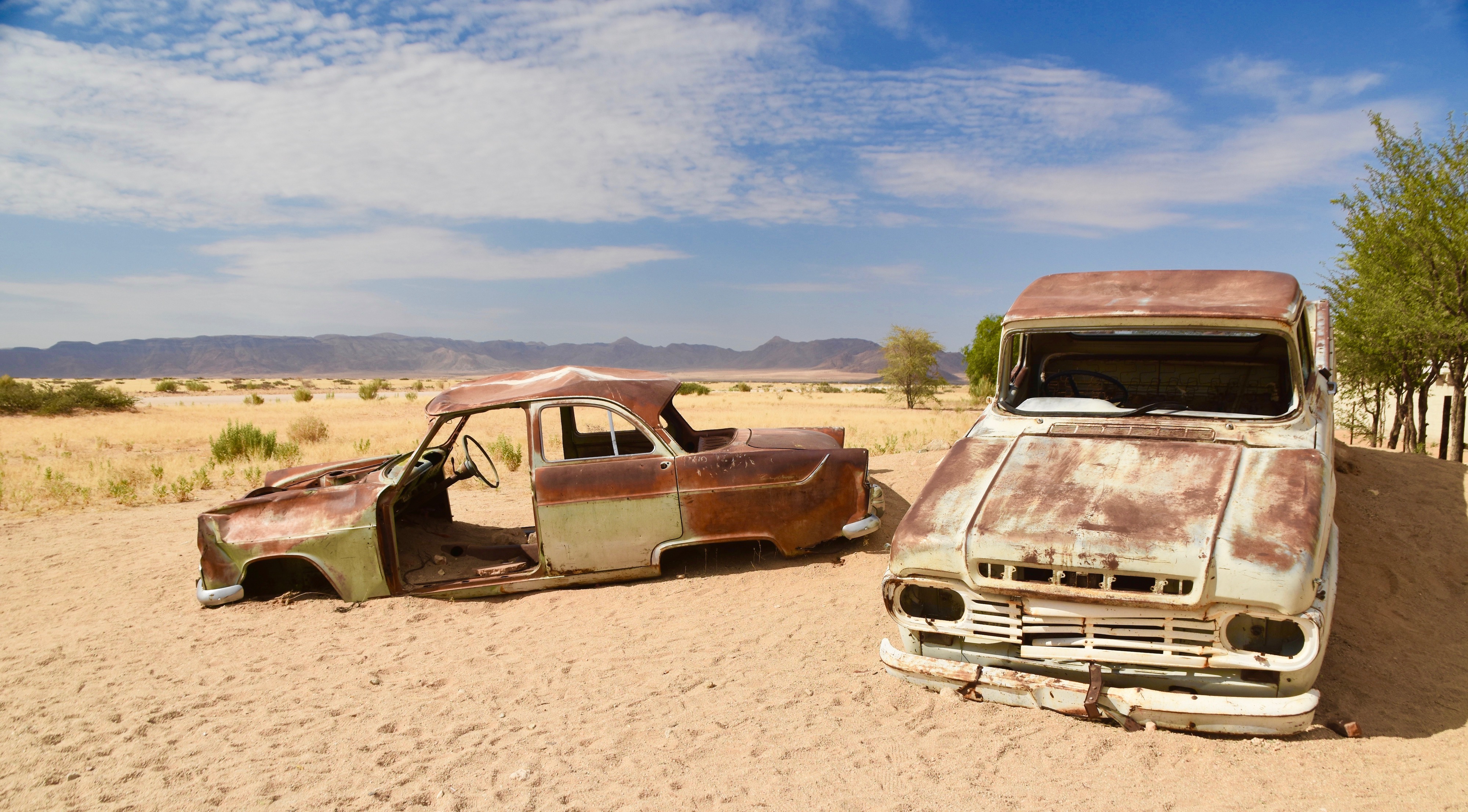
This roadster must have been something in its prime.
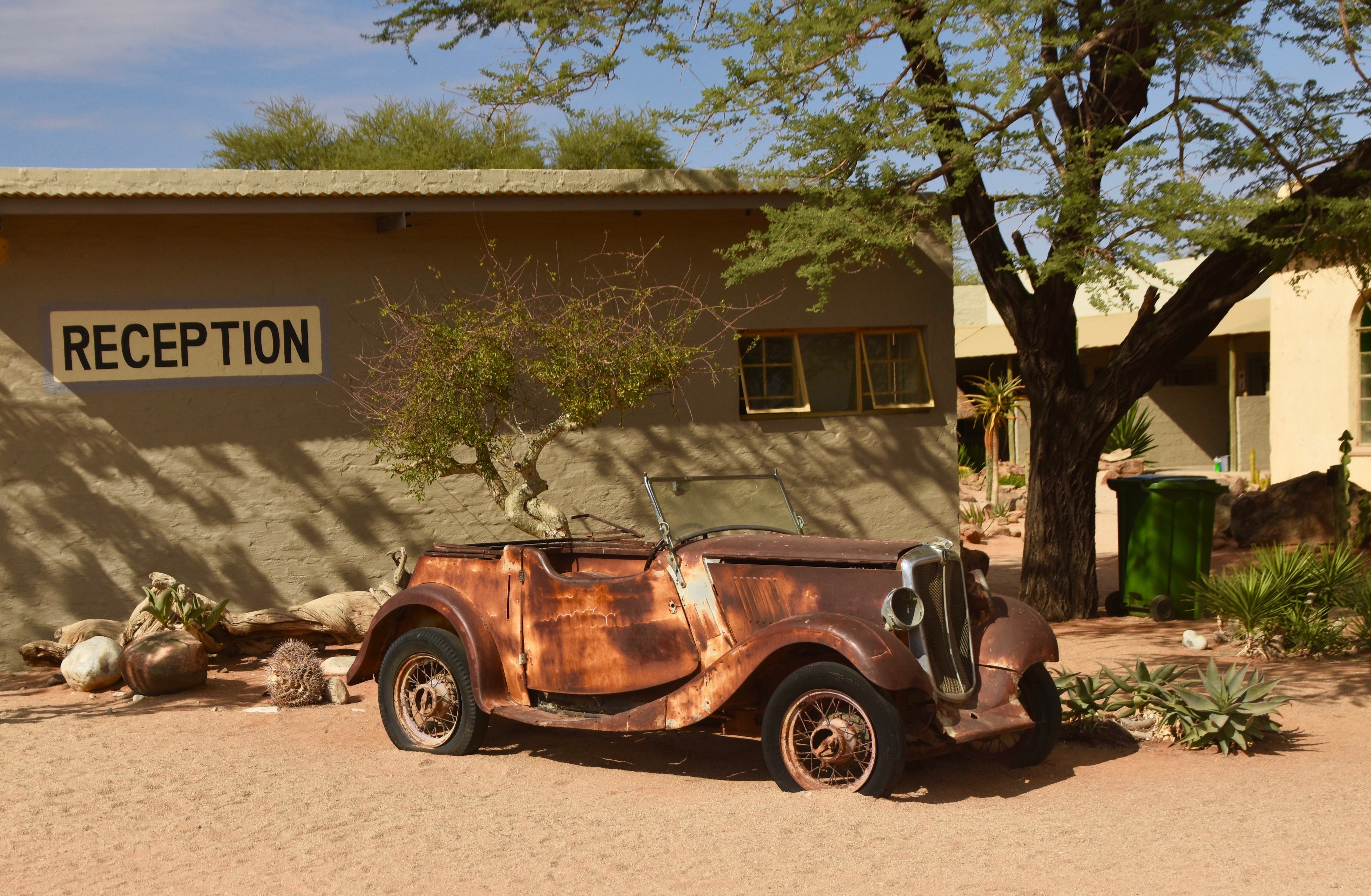
Continuing north we enter a vast expanse of emptiness that goes on for hours, broken only by the occasional oryx or zebra herd off in the distance to remind you that this is Africa and not the solitude of the American southwest or northern Mexico. You really, really would not want to breakdown out here and yet there are the remains of flattened and discarded tires every kilometre or so.
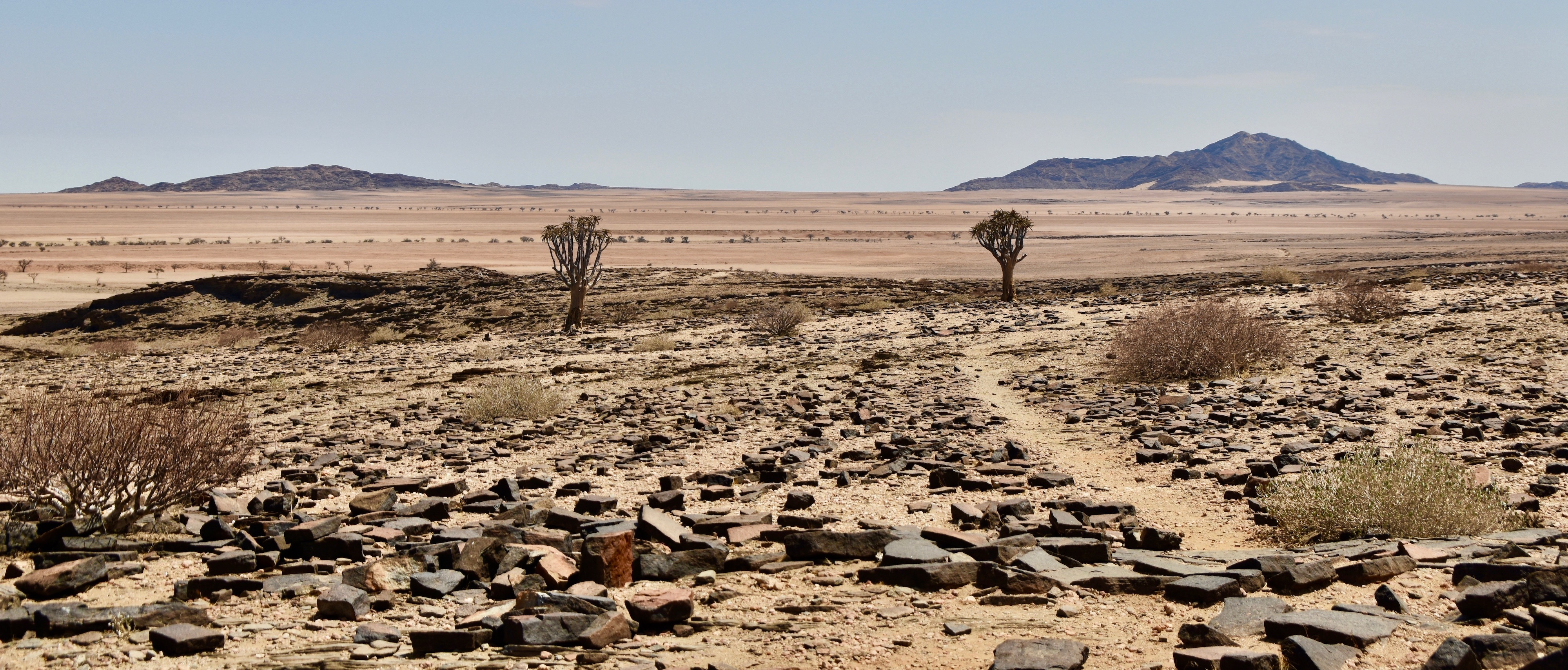
A few hours out of Solitaire we pull into a small rest area for a refreshment break where Gerhardus, one of our two guides, points out a quiver tree that is a vital resource for the San people (also called Bushmen) who have managed to survive in this hostile environment for as long as 30,000 years.
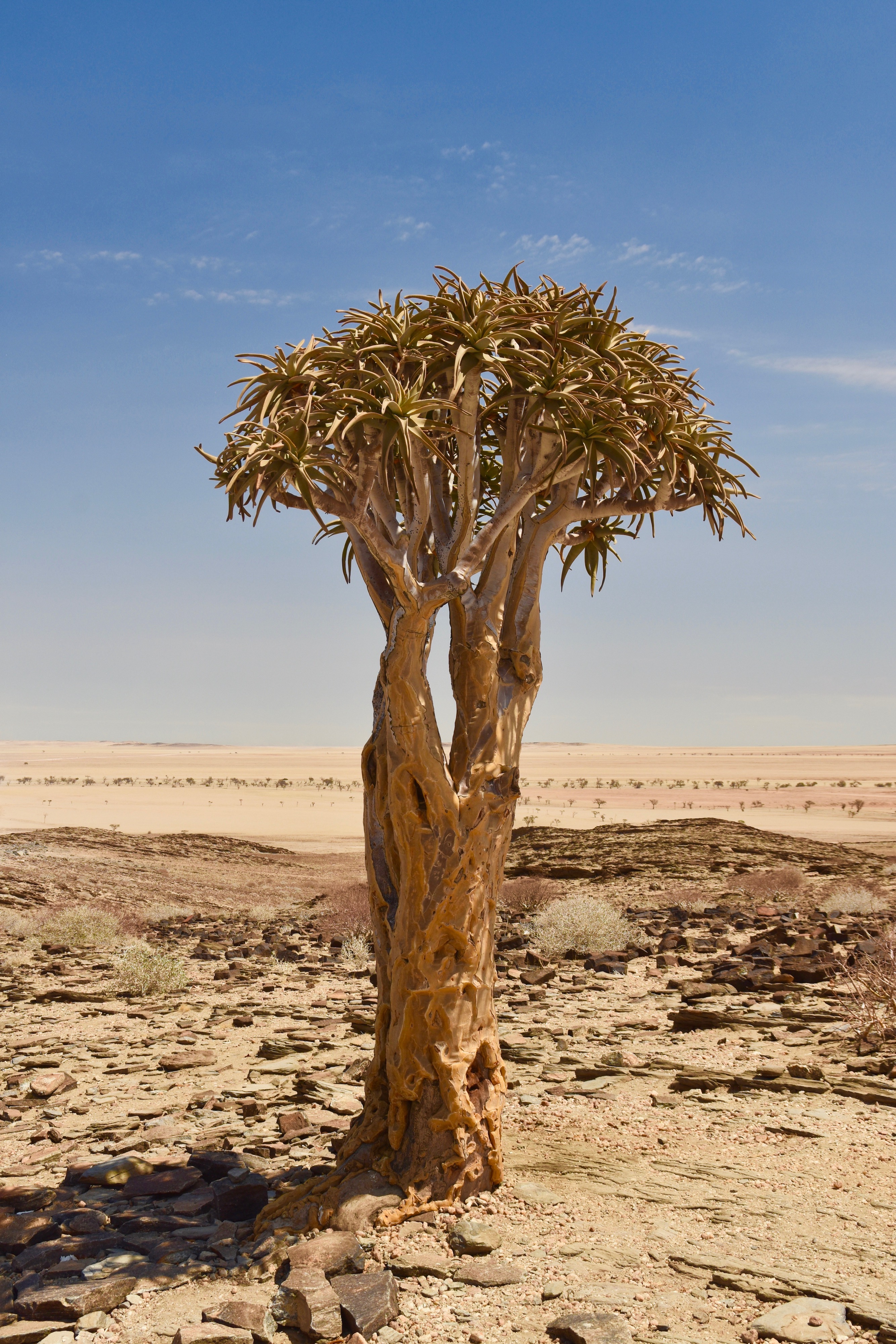
It’s called a quiver tree because the San learned how to hollow out the small upper branches and use them as a quiver for their arrows.
Notice all the rocks in the area. Tour member Ken MacDonald joins others who have preceded him in constructing Canada’s gift to the world, an inukshuk, with a little help from Alison.
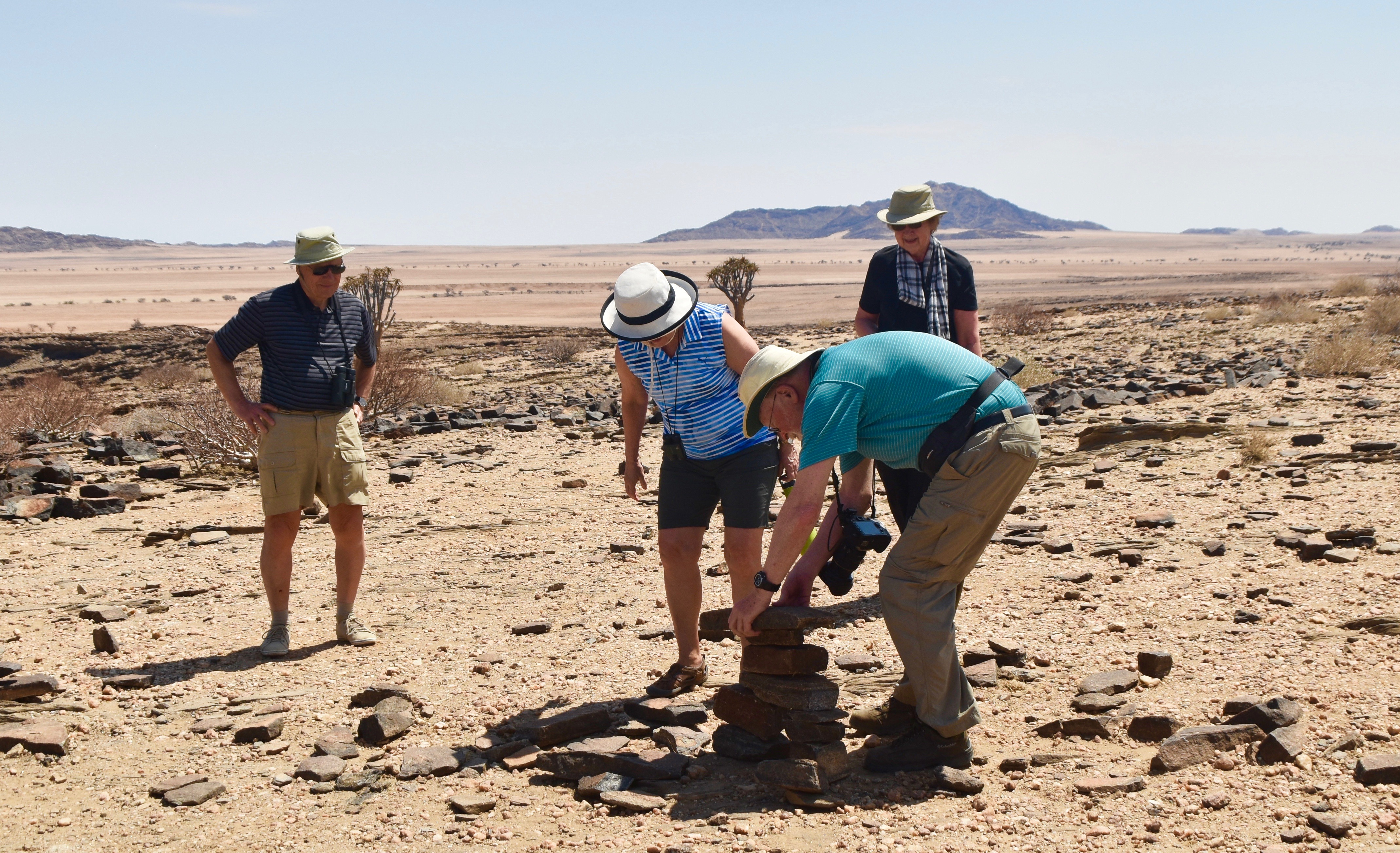
Finally we turn west again and a long time before we reach the coast we encounter the infamous and almost perpetual fog of the Skeleton Coast. This is caused by the upwelling of the very cold Benguela current waters meeting the warm air on the surface. After days of continuous sunlight it’s somewhat eerie to drive into the mist and feel the temperature drop like a stone.
Walvis Bay
We reach the coast at Walvis Bay (pronounced Walvish) and named for the whales that once frequented the Skelton Coast until 19th century whalers pretty well wiped them all out. Now southern right whales are as rare as their cousins the northern right whales which are still seen in small numbers in the Bay of Fundy.
For me Walvis Bay has always had a certain fascination. As a fanatic reader of maps, atlases and globes from a very early age I always noted when looking at a map of Africa that there was only one place on the Atlantic Coast between Cape Town and Luanda that ever seemed to appear and that was Walvis Bay. It seemed incredibly remote and romantic place to me – sort of a coastal Timbuktu. And yet here I am, in Walvis Bay. I almost need to pinch myself.
While the whales are mostly gone, the flamingoes and pelicans which have made Walvis Bay a top birding destination remain. They are here by the hundreds. This is a majestic Greater Flamingo that may or may not migrate north to the great salt pan at Etosha which we will be visiting later on this tour. Right now there is not enough water in Etosha for them to breed so they will stay here. The question is – how do they know what the conditions are like in Etosha hundreds of kilometres to the north? Nobody but the flamingoes knows the answer and they aren’t telling.
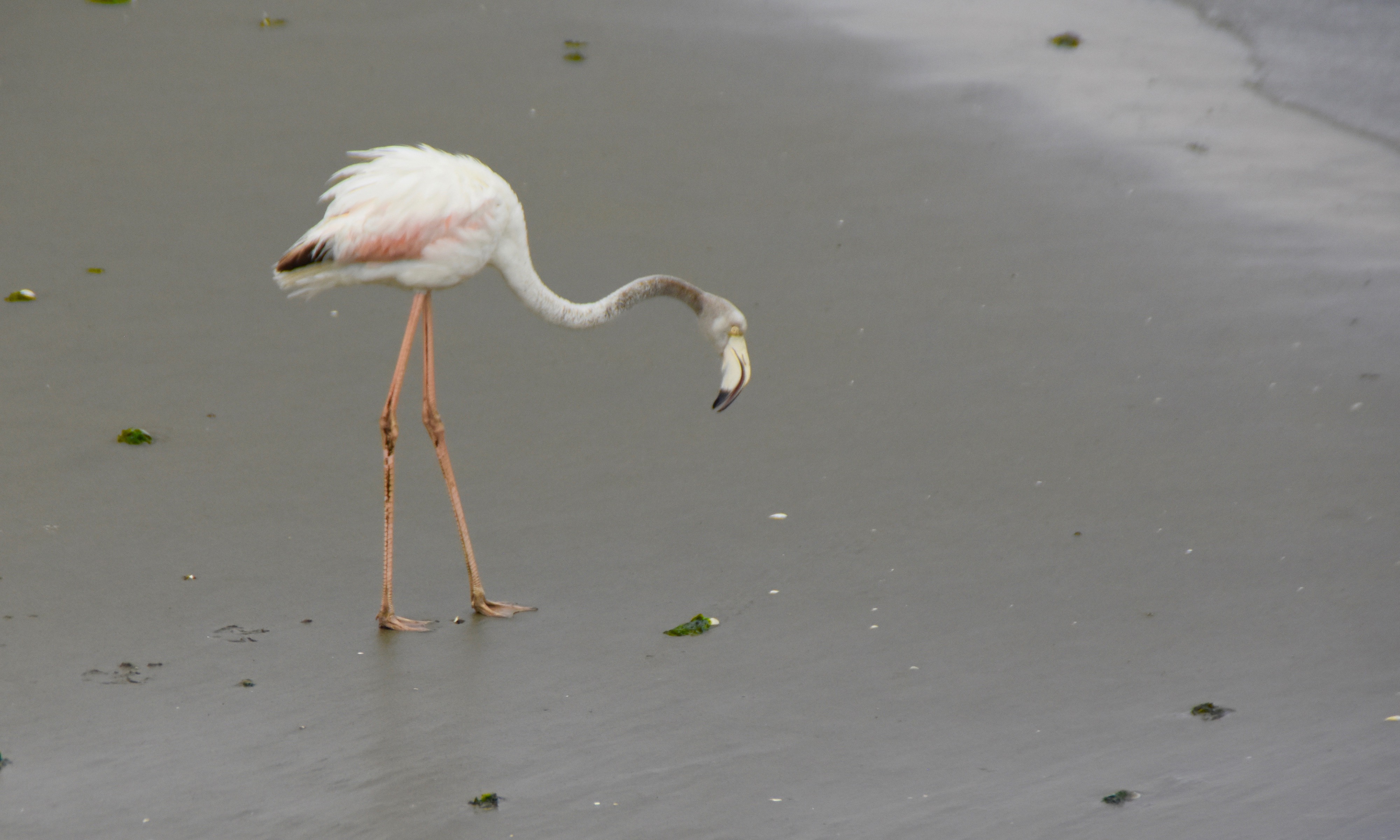
The one thing I would change if I could on this tour would be to spend more time watching the birds in the Walvis Bay Wetlands, but I realize that not everybody is ‘for the birds’.
By now it was mid-afternoon and we stopped at this restaurant, aptly named The Raft, for a late lunch.
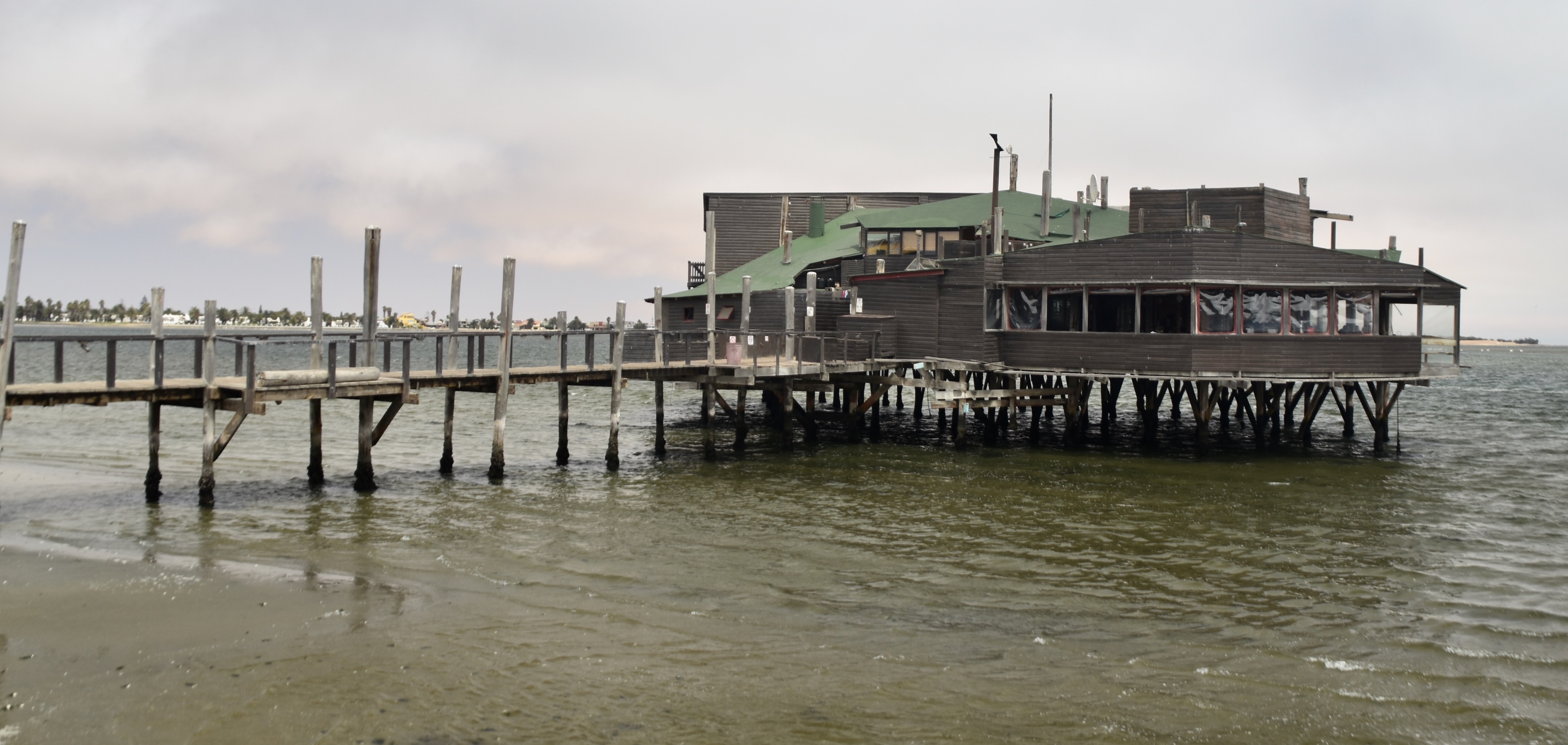
This was our first chance to have seafood in Namibia which has a thriving fishery based out of Walvis Bay. Here I was introduced to one of the very best fishes I have ever tasted – the beautifully firm white flesh of the kingklip. I am writing this post in Cape Town airport and thinking about the fabulous kingklip I had two nights ago at Baia restaurant on the Victoria & Alfred Waterfront. Thank you Adventures Abroad for giving me the opportunity to taste and appreciate this southern African piscatory masterpiece. The irony is that kingklip is closely related to a cusk and just as homely looking. Back home where cusk are plentiful, you couldn’t give them away to most people, let alone sell them and that includes me, but now I’m willing to give it a try.
It’s only 43 kms. (27 miles) between Walvis Bay and Swakopmund where we will spend the next two nights and it’s on a paved road.
Swakopmund Namibia
While I certainly had known of Walvis Bay, I knew nothing about Swakopmund prior to seeing it on the itinerary of this Namibian trip. In retrospect, that seems strange because, except for the birding, Swakopmund is a much more interesting place than Walvis Bay. It is a resort town (small city actually) that attracts people for the very reasons why Canadians flee to the south during winter – it is cold and not sunny. In Namibia those are good things. I know that sounds strange, but it’s true – escaping the glare and heat of the Namibian sun is a priority.
So is Swakopmund or Swako as every who lives there calls it, really a German town? I’ll let you judge by these pictures.
Does this look like an African streetscape?
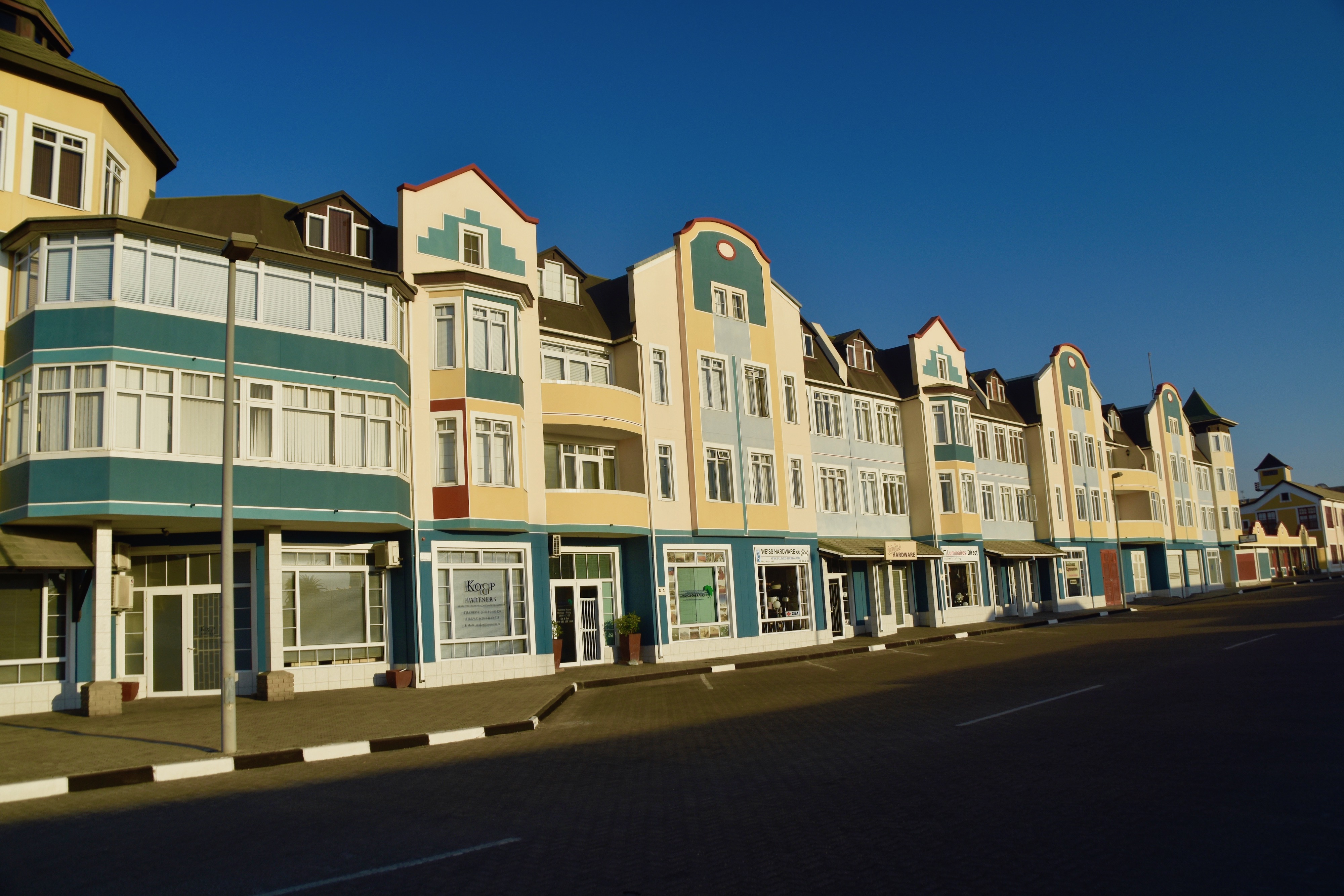
Or this?
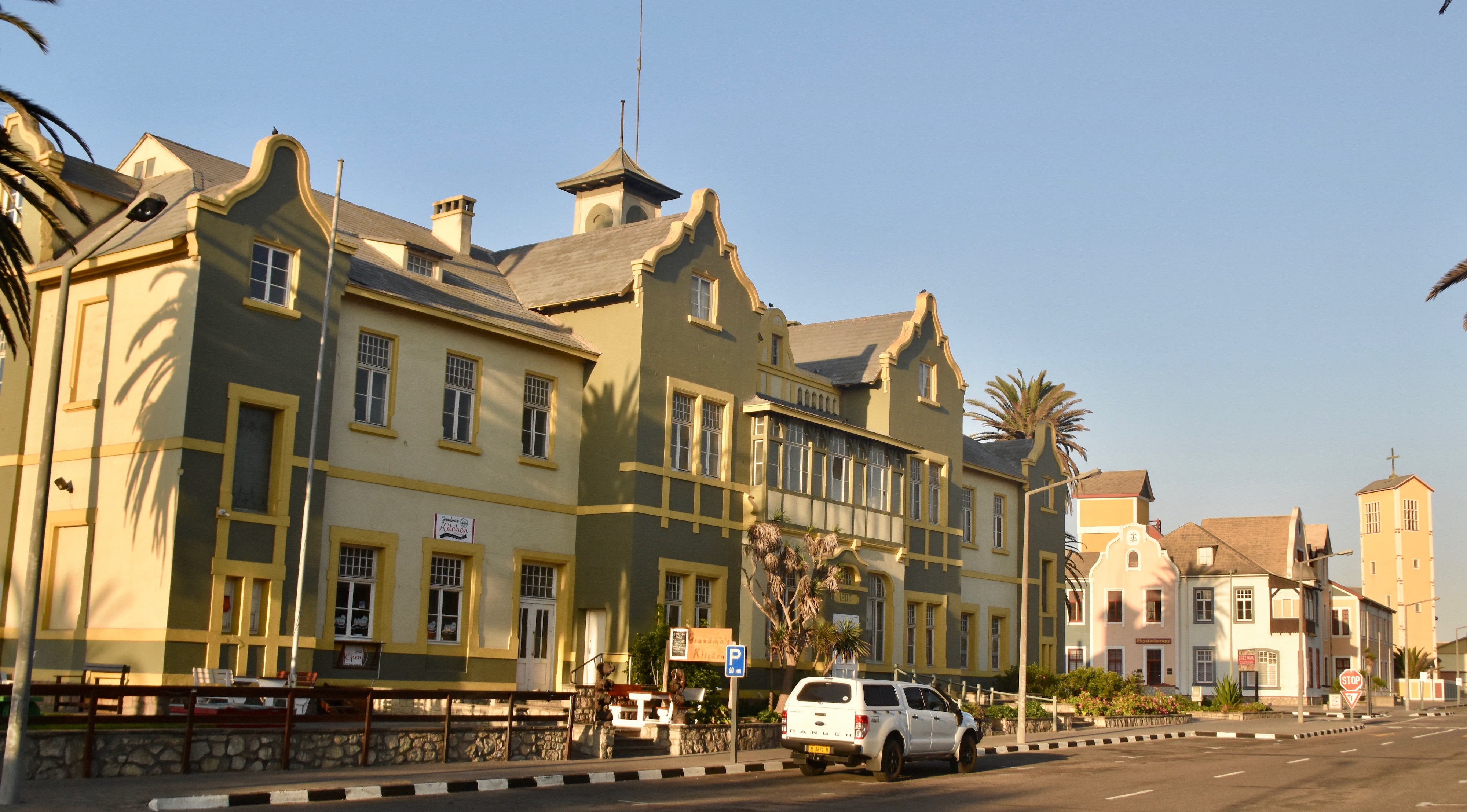
How about these businesses?
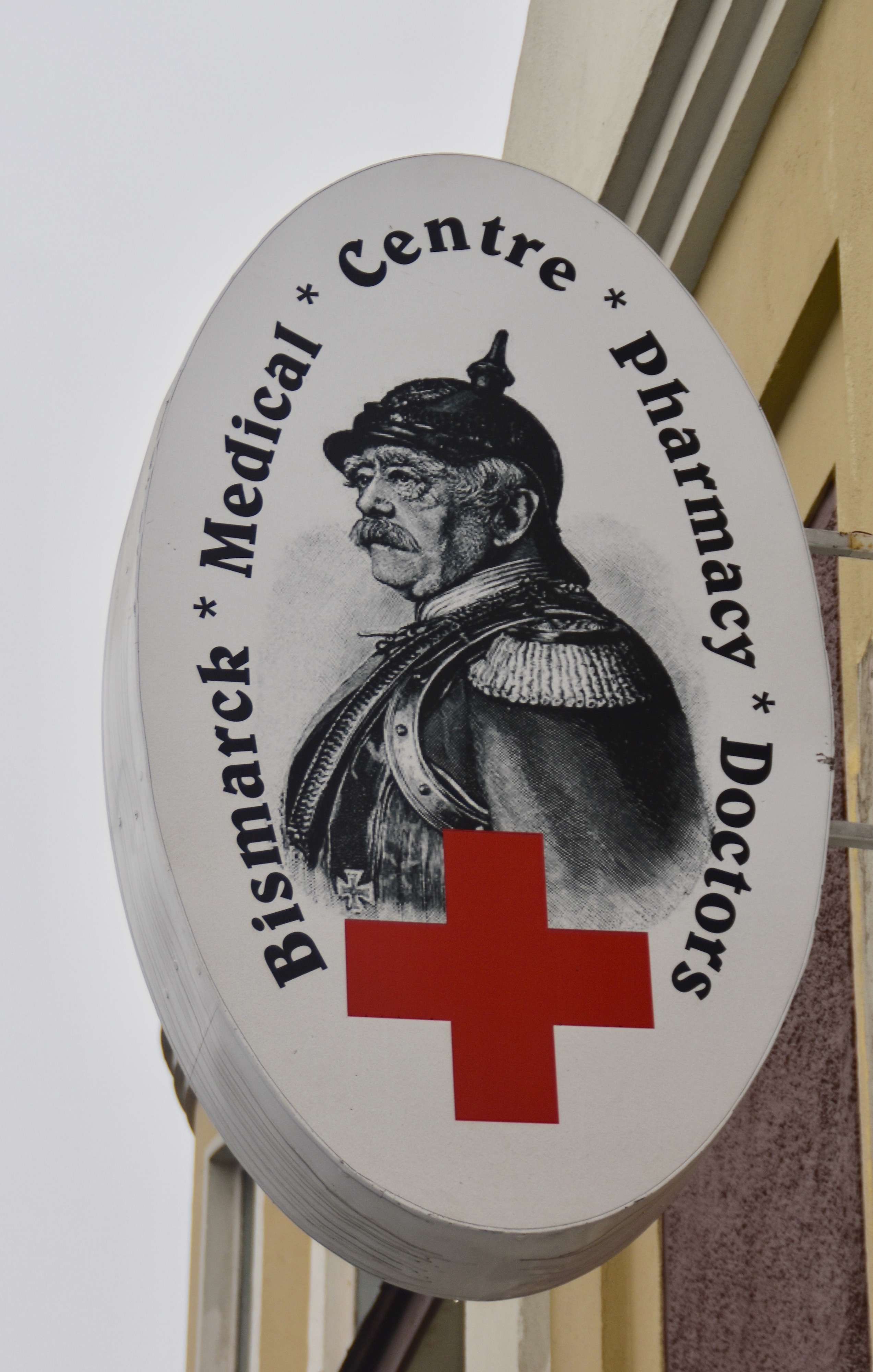
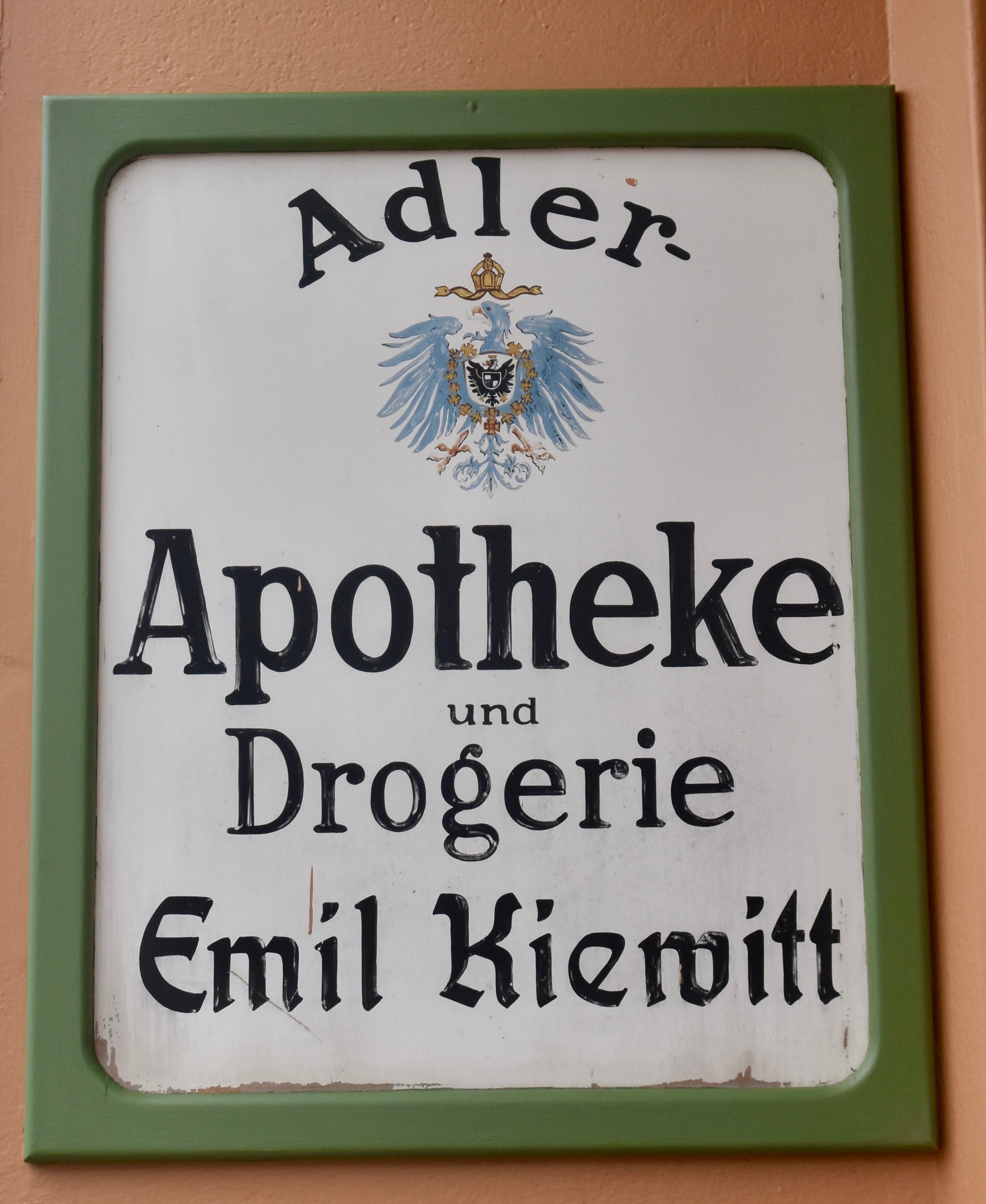
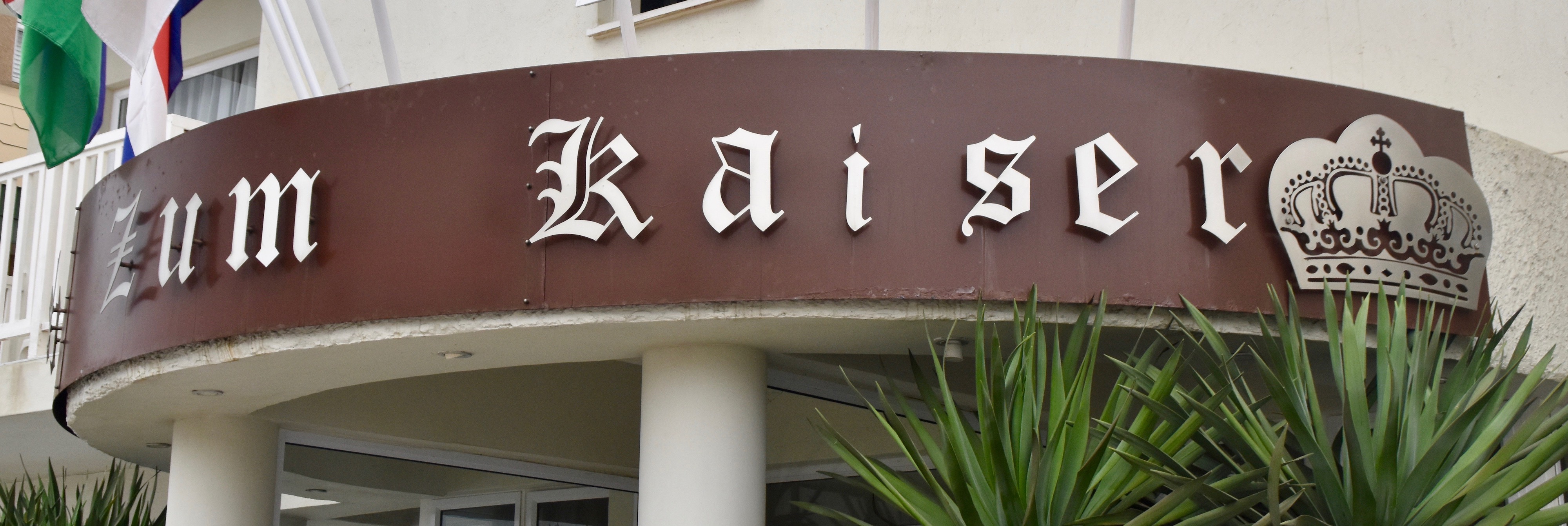
And yes, the great majority of the tourists we encountered in Swakopmund were Germans. Why they would fly thousands of miles to a town that looks exactly like any number of North Sea resort towns in Germany is hard to fathom. After all, the beaches are too cold for the the nude bathing they seem to prefer.
Hansa Hotel
Our place of rest for the next two nights was the delightful 114 year old Hansa Hotel. I say delightful because it is a throwback to an era of hotelry you seldom encounter any more. They have bell boys that are dressed in blue livery with those really neat little round bell boy hats. The room keys are actually real keys. There is a dress code for the dining room. If this place was in Germany you would say it was stuffy, but in Namibia it’s more like a spoof on stuffiness.
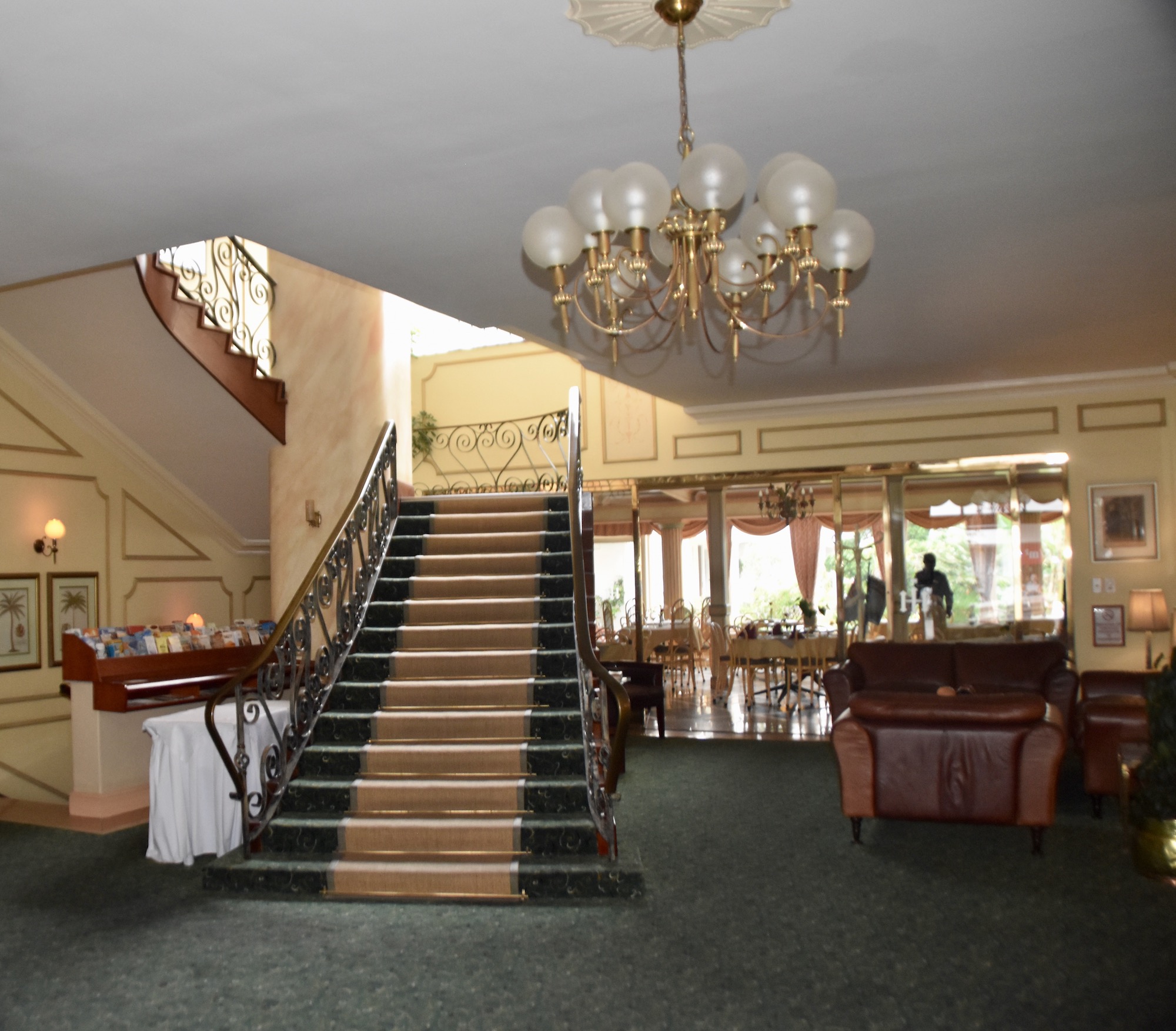
After settling in and checking out the Hansa’s really nice garden and fountain that acted as a birdbath for a variety of locals we headed out for dinner.
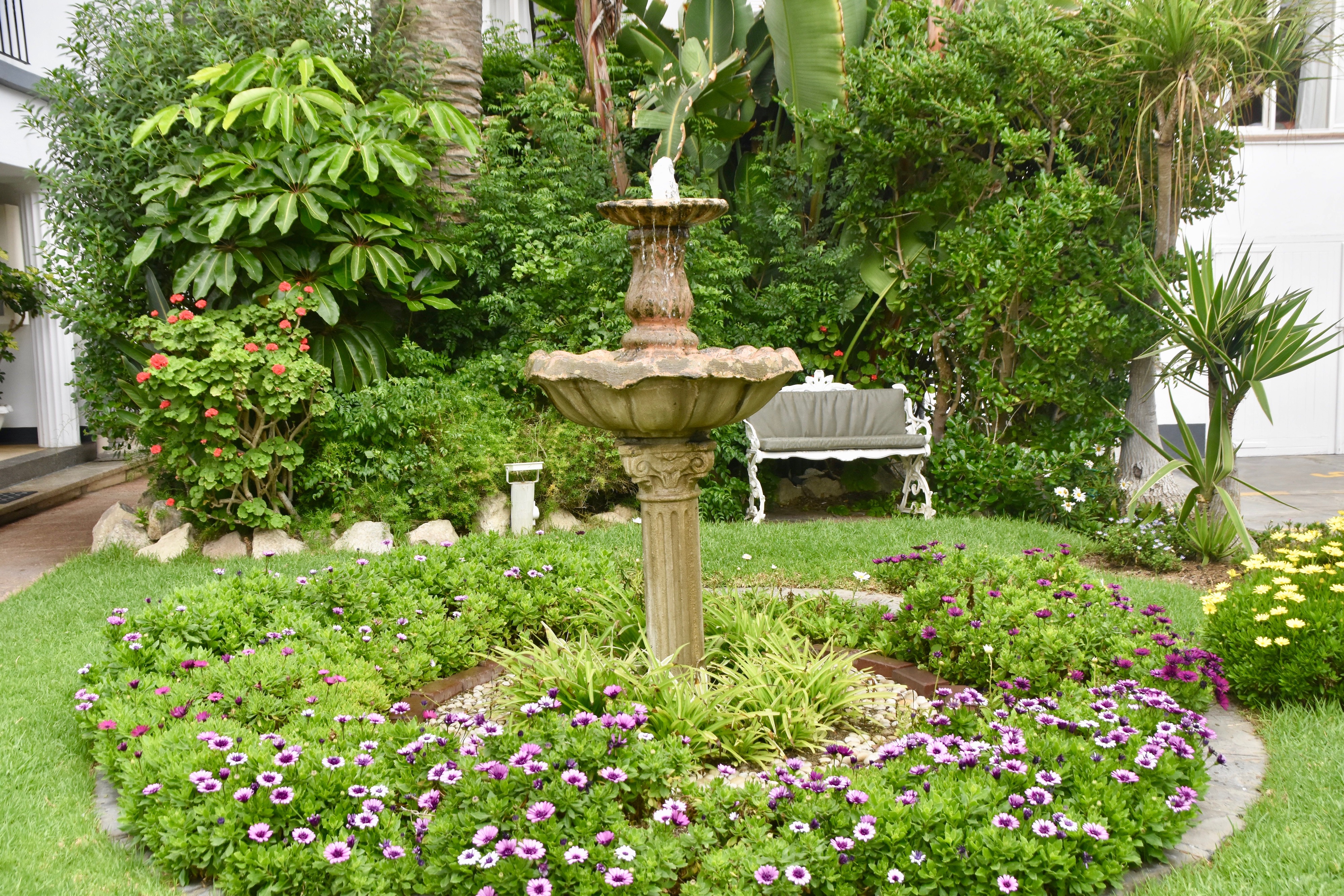
The Tug Restaurant has a great location on the Swakopmund waterfront just beside the jetty or pier as most North Americans would call it. Outside there are a number of very interesting creations made from driftwood including this elephant.
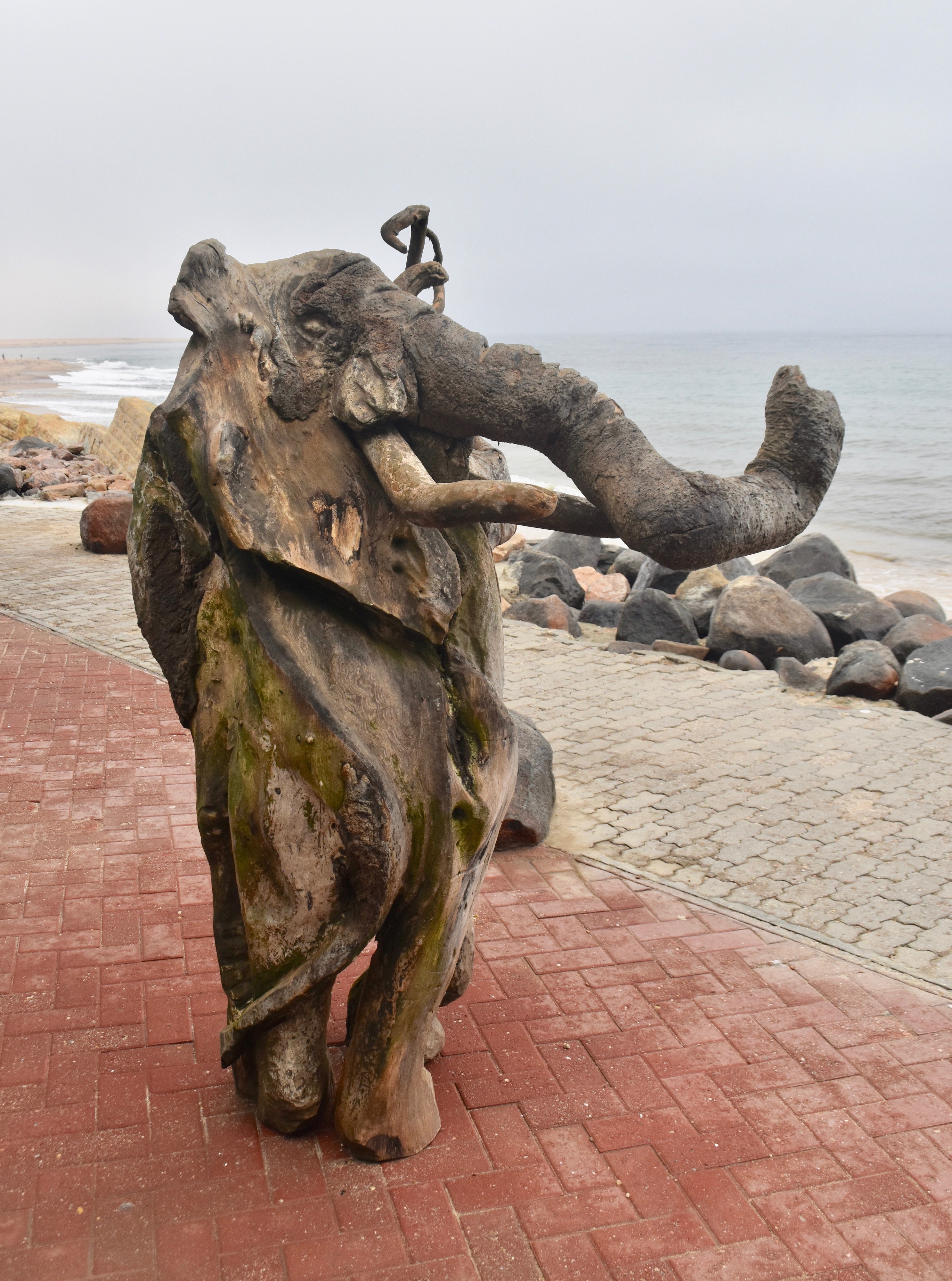
And this vulturine chair Alison is sitting in.
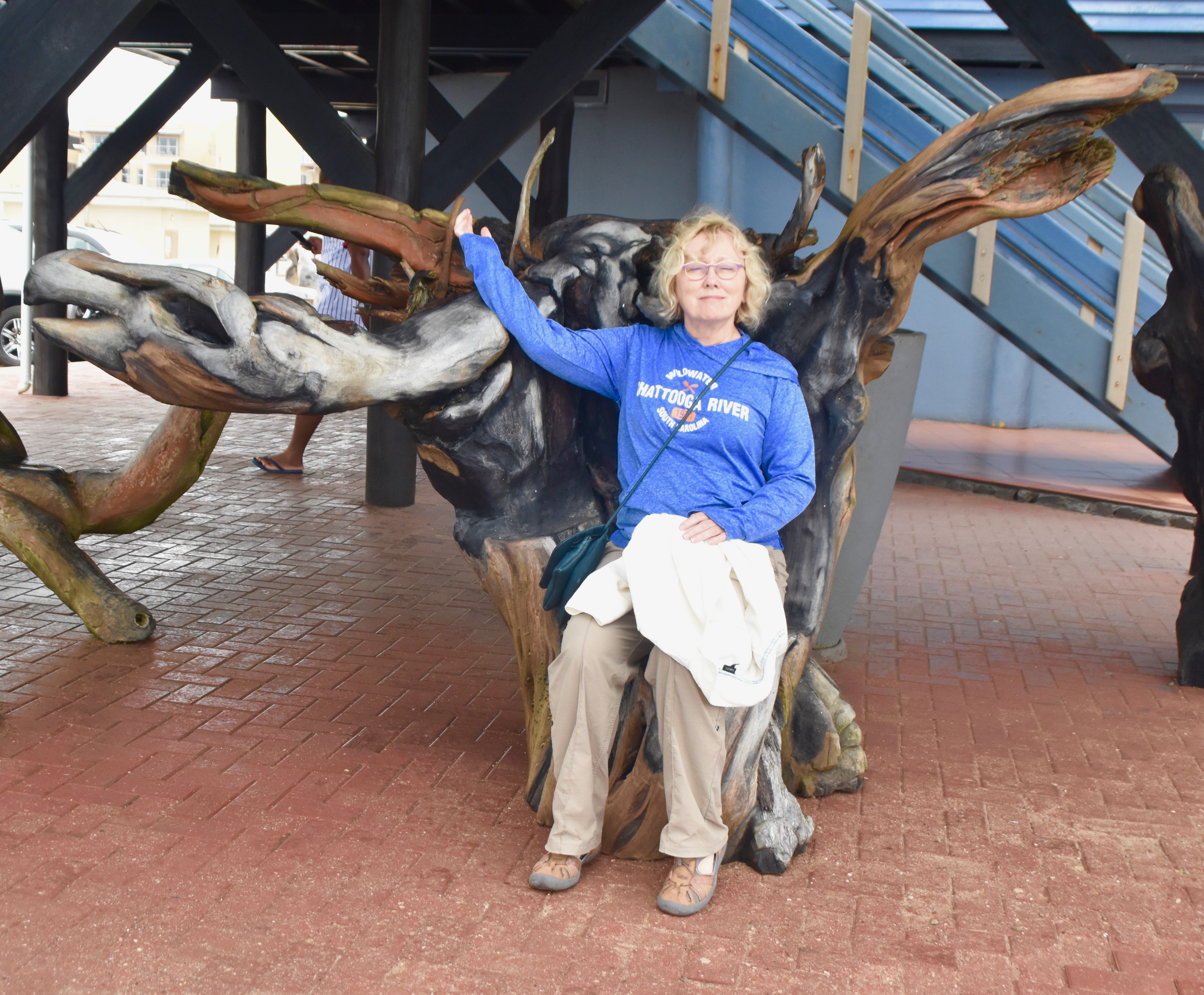
Inside there was more fantastic Namibian seafood accompanied with excellent South African wine. Honestly, when I signed up for this trip, the last thing I was expecting was great food and drink, but then again, that’s why we travel n’est-ce-pas?
What To Do In Swakopmund
The next day we were free to do as we wished and Swakopmund offered a huge number of options including deep sea fishing, desert nature trips, returning to Walvis Bay for birding or even sky diving. Originally we had hoped to take a small fixed wing plane on an aerial tour of the Skeleton Coast, but the price was surprisingly prohibitive, so we opted to just explore Swakopmund on foot. It turned out to be a good and relatively inexpensive option.
I’m a sucker for lighthouses so the first place we headed for for Swakopmund’s, coming across this sign on the way.
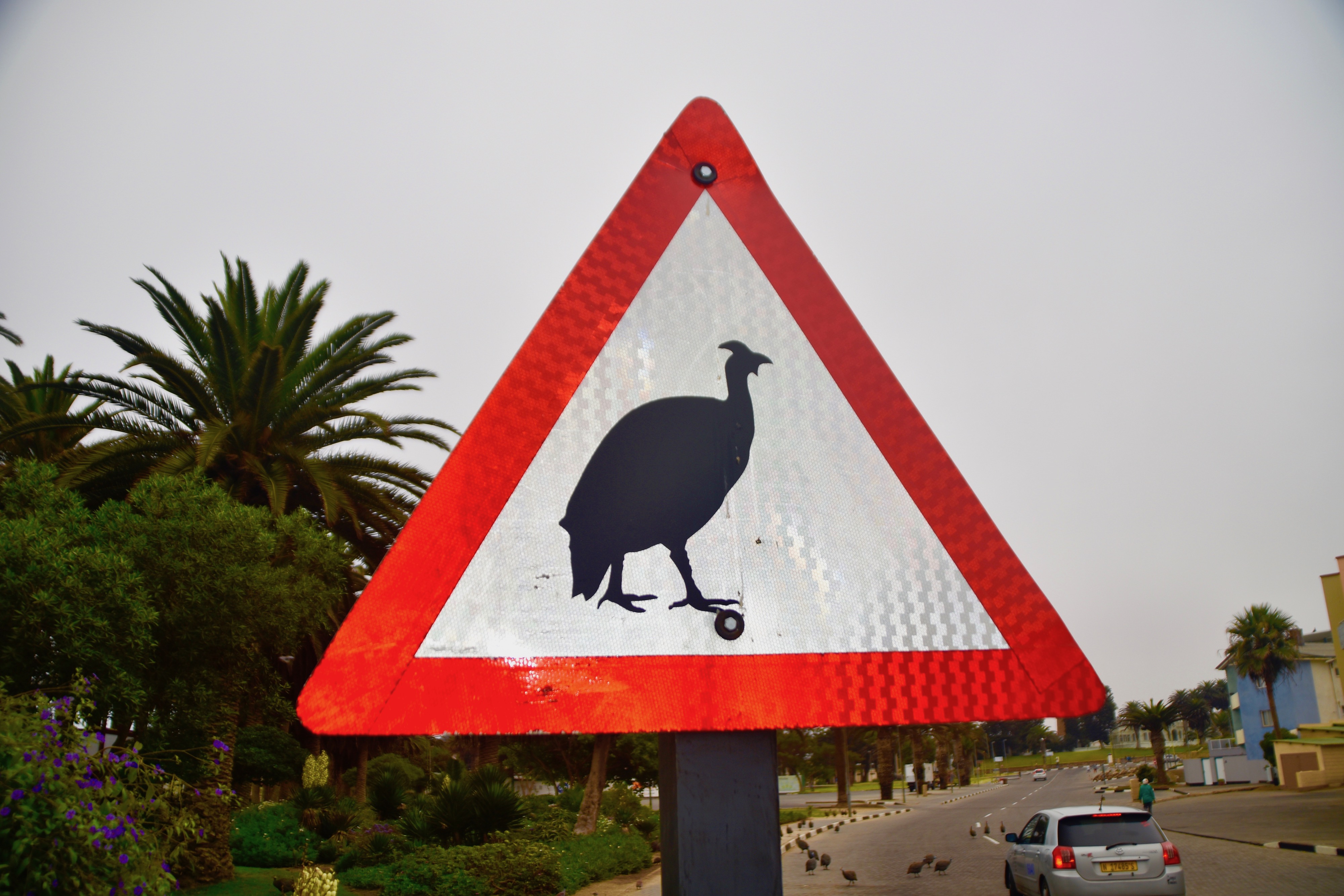
The Helmeted Guinea Fowl is ubiquitous in sub-Saharan Africa and after warthogs, probably the most amusing creatures you’ll come across. They are as stupid as a bag of hammers and the males are constantly squabbling if not outright battling over their homely females. In recent years they have moved into cities like Swakopmund where they generally find a kindly soul like this lady who thinks that feeding them is a good idea. Well it does fatten them up for the less fortunate who can’t afford to buy chicken at the local market, although I am told by Gerhardus and Perez that they are very tough. A popular anecdote says that in order to cook a guinea fowl, you put it in water with a rock and when the rock is done so is the bird.
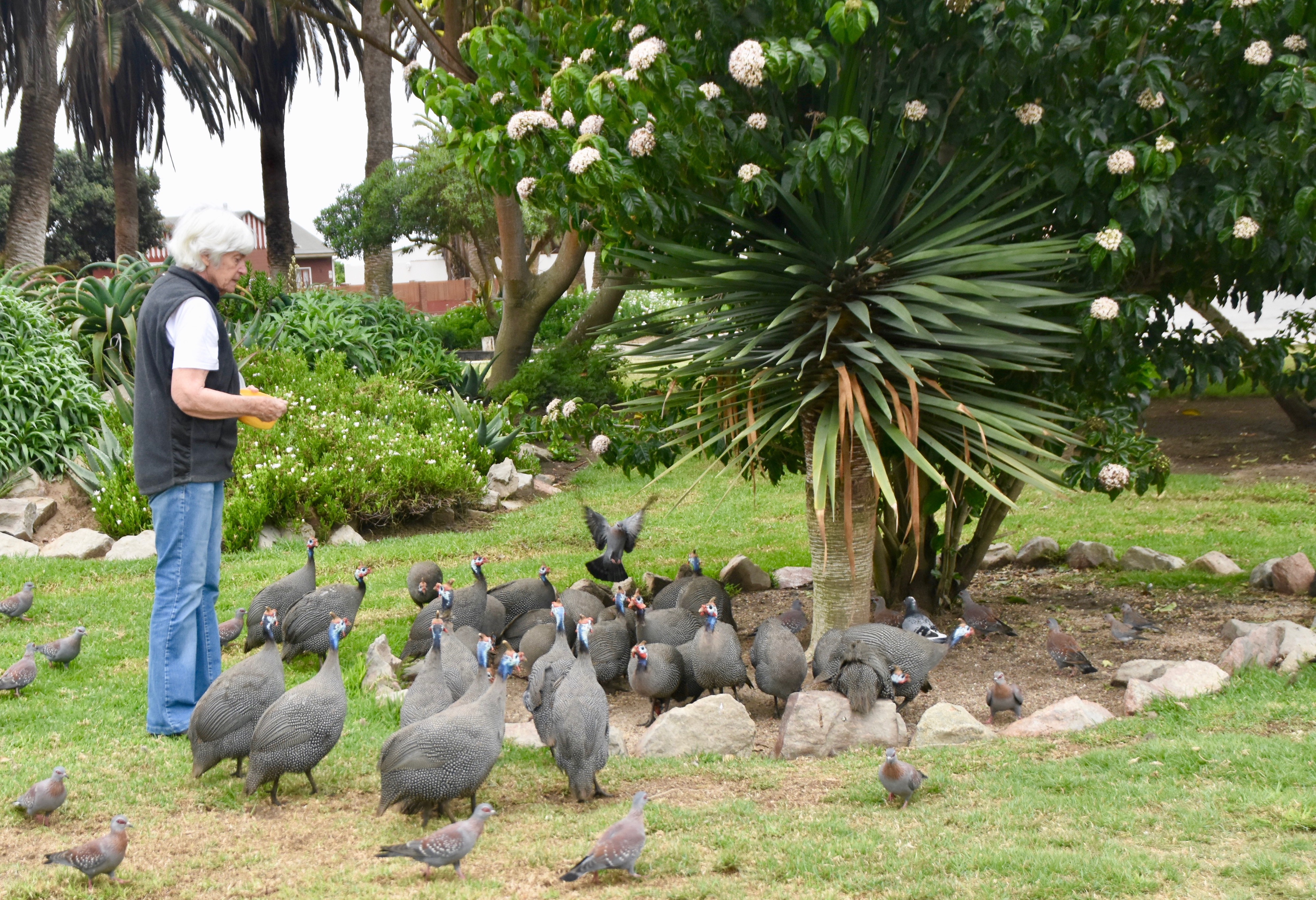
This is the Swakopmund lighthouse which dates back to 1902 and, unlike most lighthouses, is actually still in operation, its beam visible from 35 miles at sea. The amazing thing about lighthouses is that, although they all share relatively the same design, no two are alike. I bet you’ll find up to fifty different ones on this website alone.
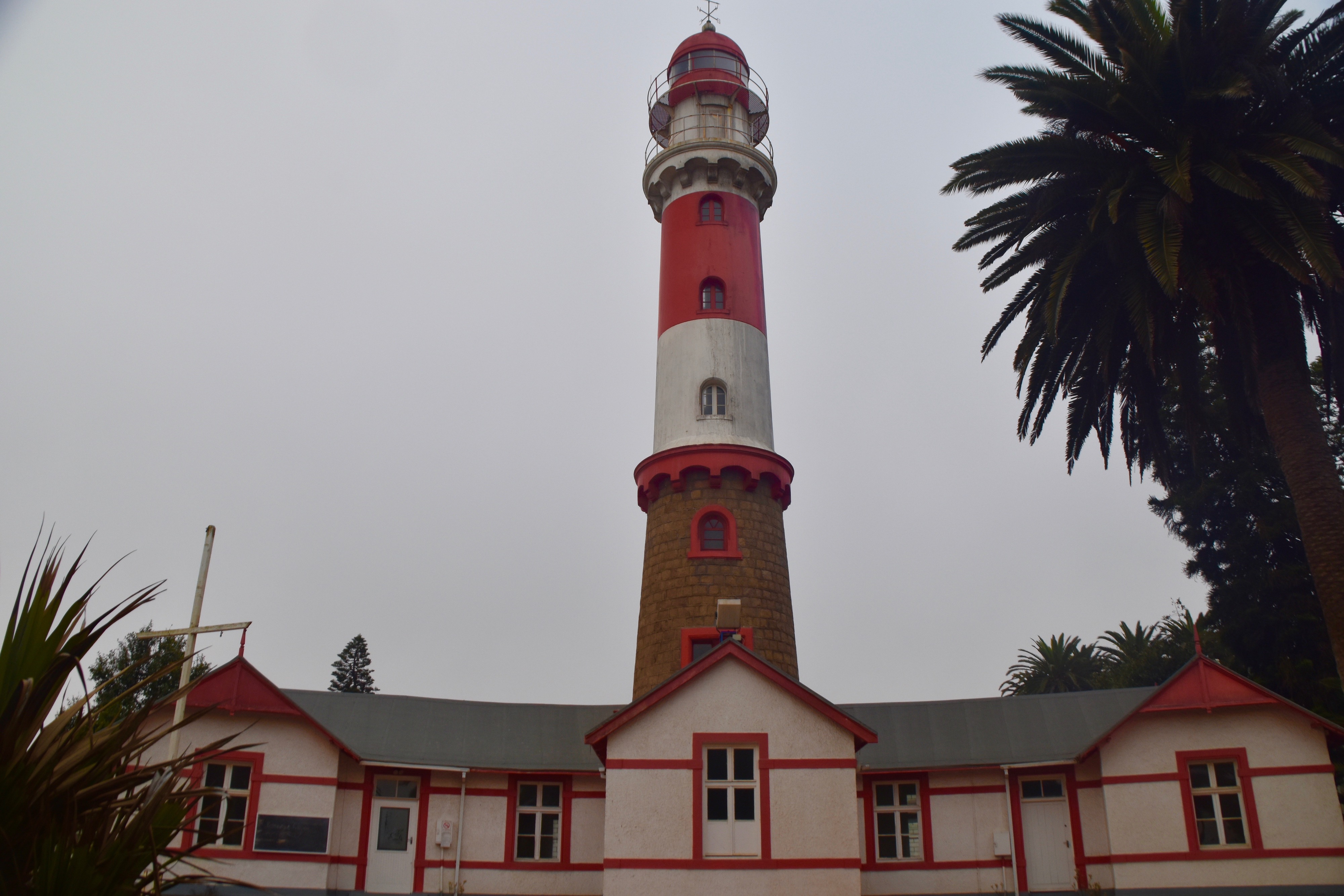
The seafront of Swakopmund is extensive, but for touristic purposes generally runs from the mole, (which is not an burrowing mammal, a spy or a Mexican sauce, but rather a breakwater) to the jetty aka the pier – a distance of about half a kilometre which is a wide sandy beach very suitable for beach-combing. This is the view from the mole looking north, away from the pier.
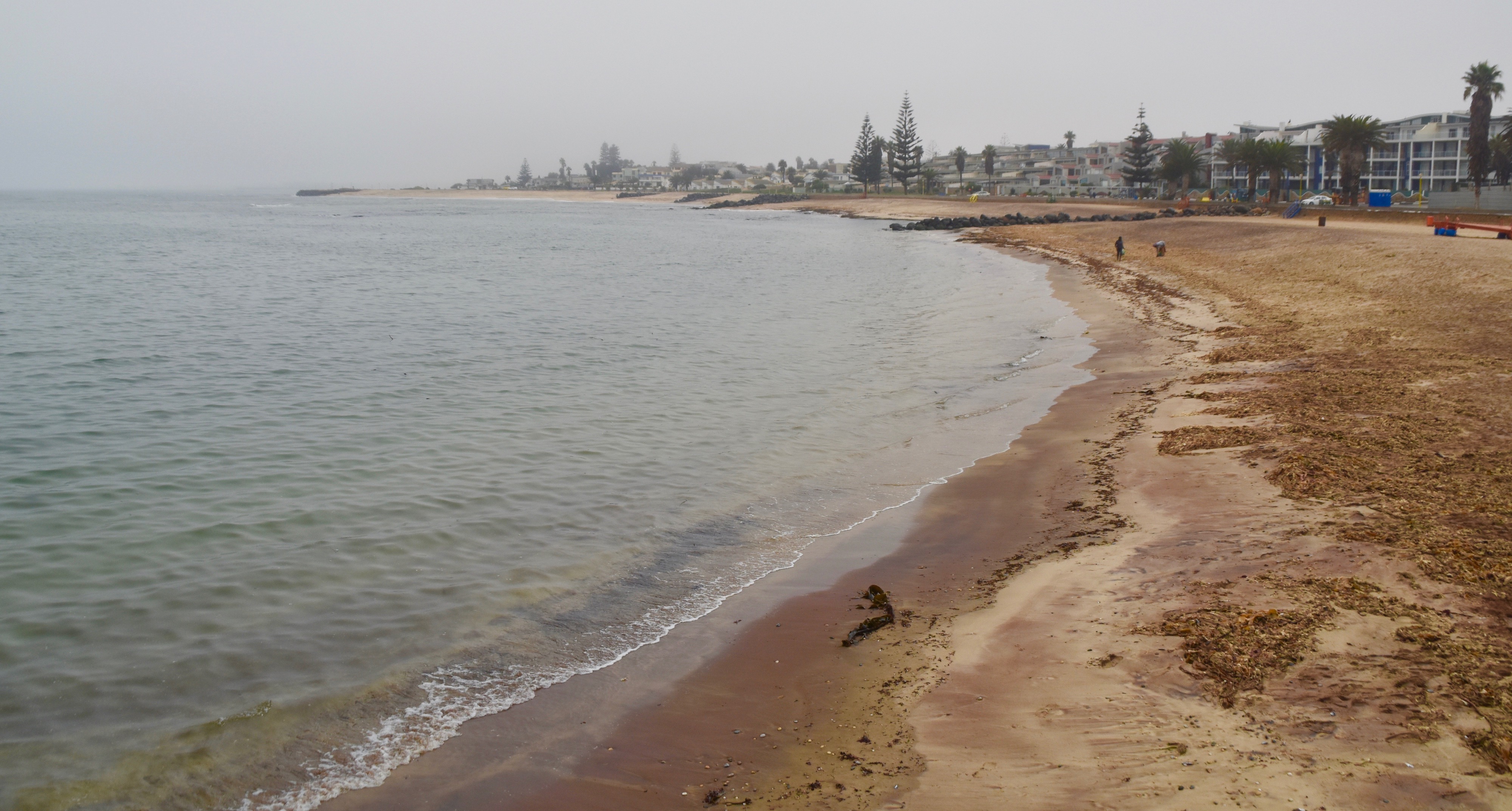
While most people would consider the water too cold for swimming, that was not the case for these four Namibian boys who were boys being boys. Their sheer joy was infectious, but not enough to tempt me to don my swimming trunks.
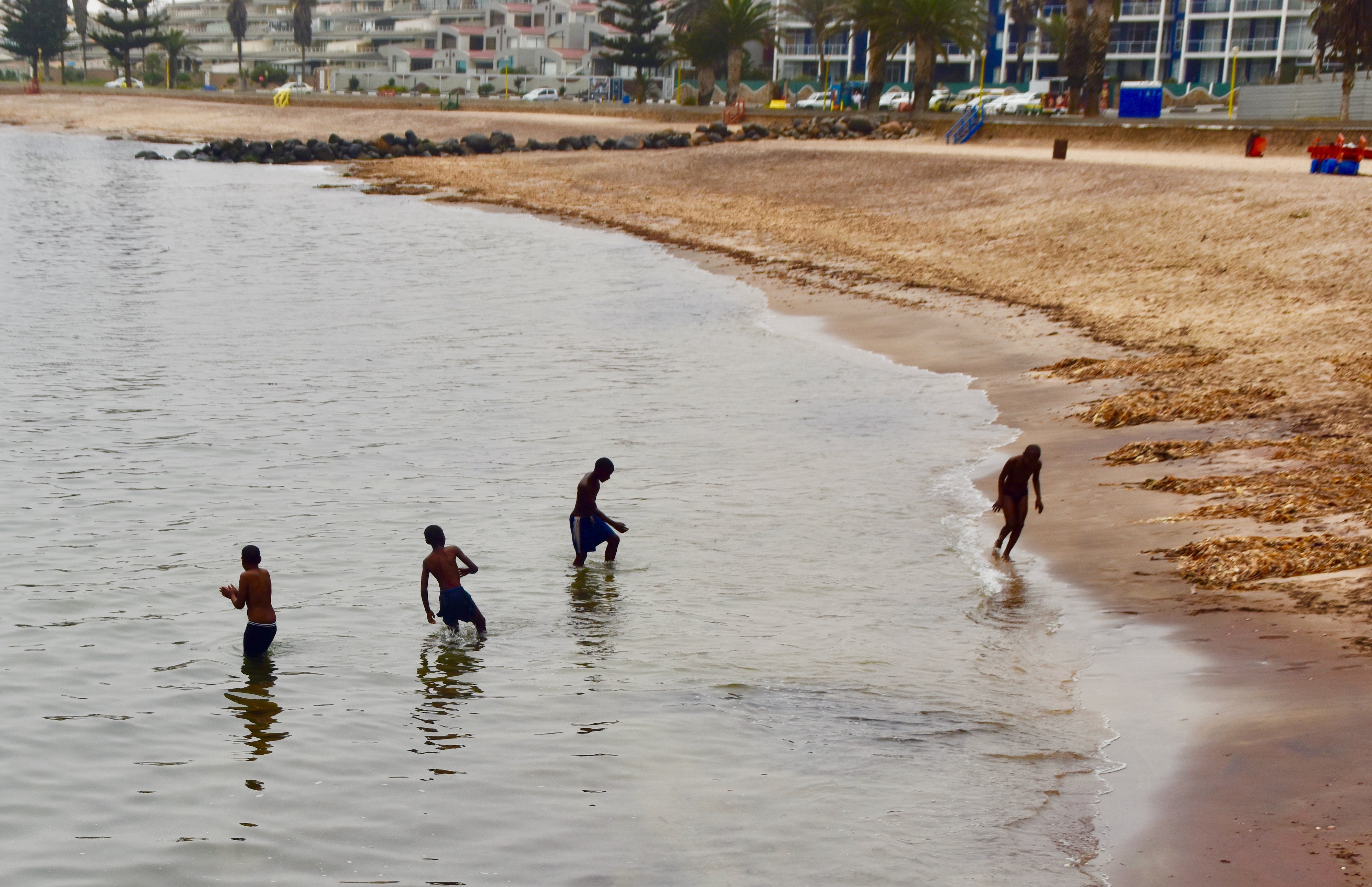
Close to the mole and the lighthouse is Swakopmund’s very interesting museum where we spent an hour or so learning a lot more about Swakopmund, its German heritage and the flora and fauna of the Skeleton Coast.
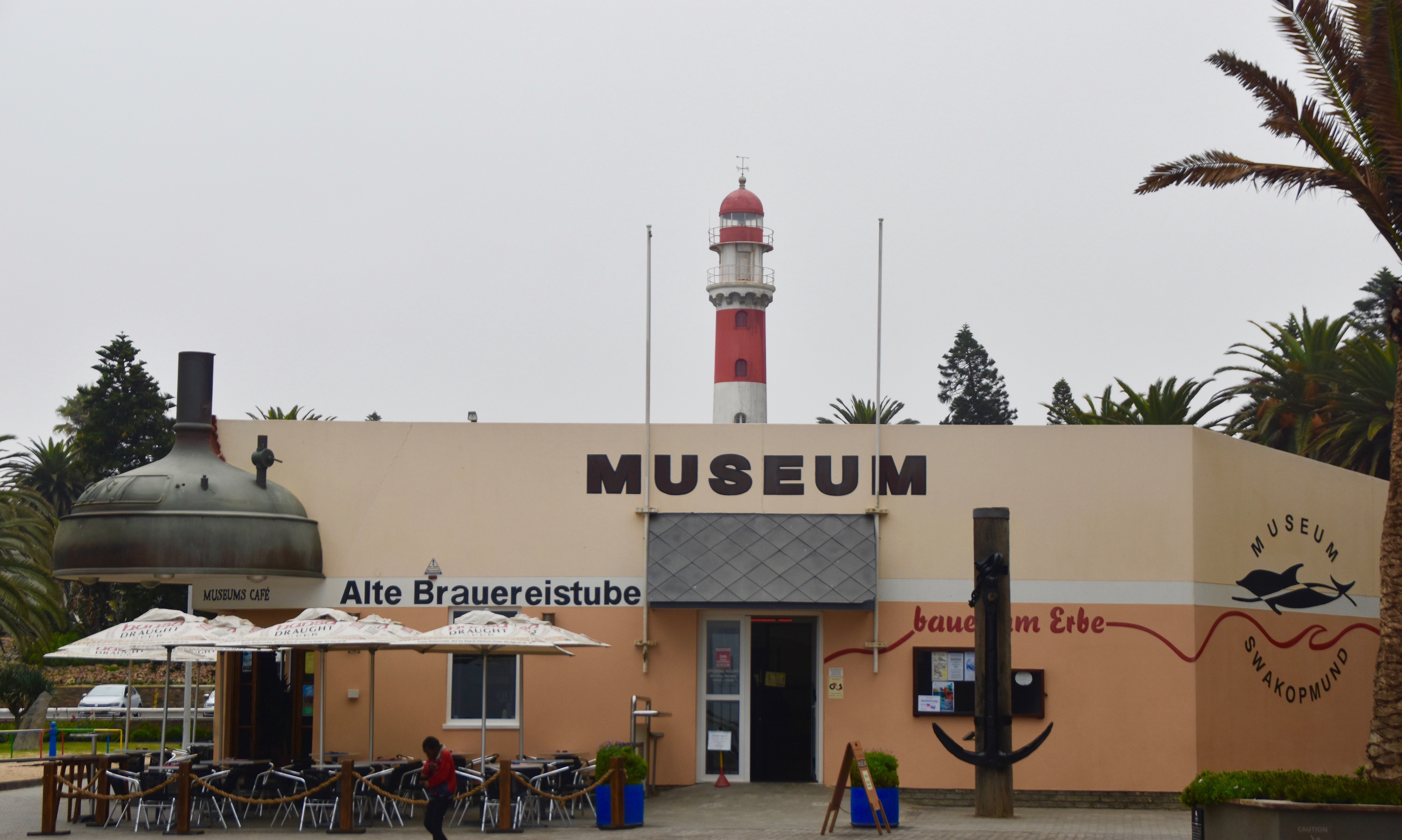
The museum was started by a local dentist who thought it fitting to donate the entirety of his office to the museum, bringing back memories of childhood torture on a scale equalled only by the infamous scene from The Marathon Man.
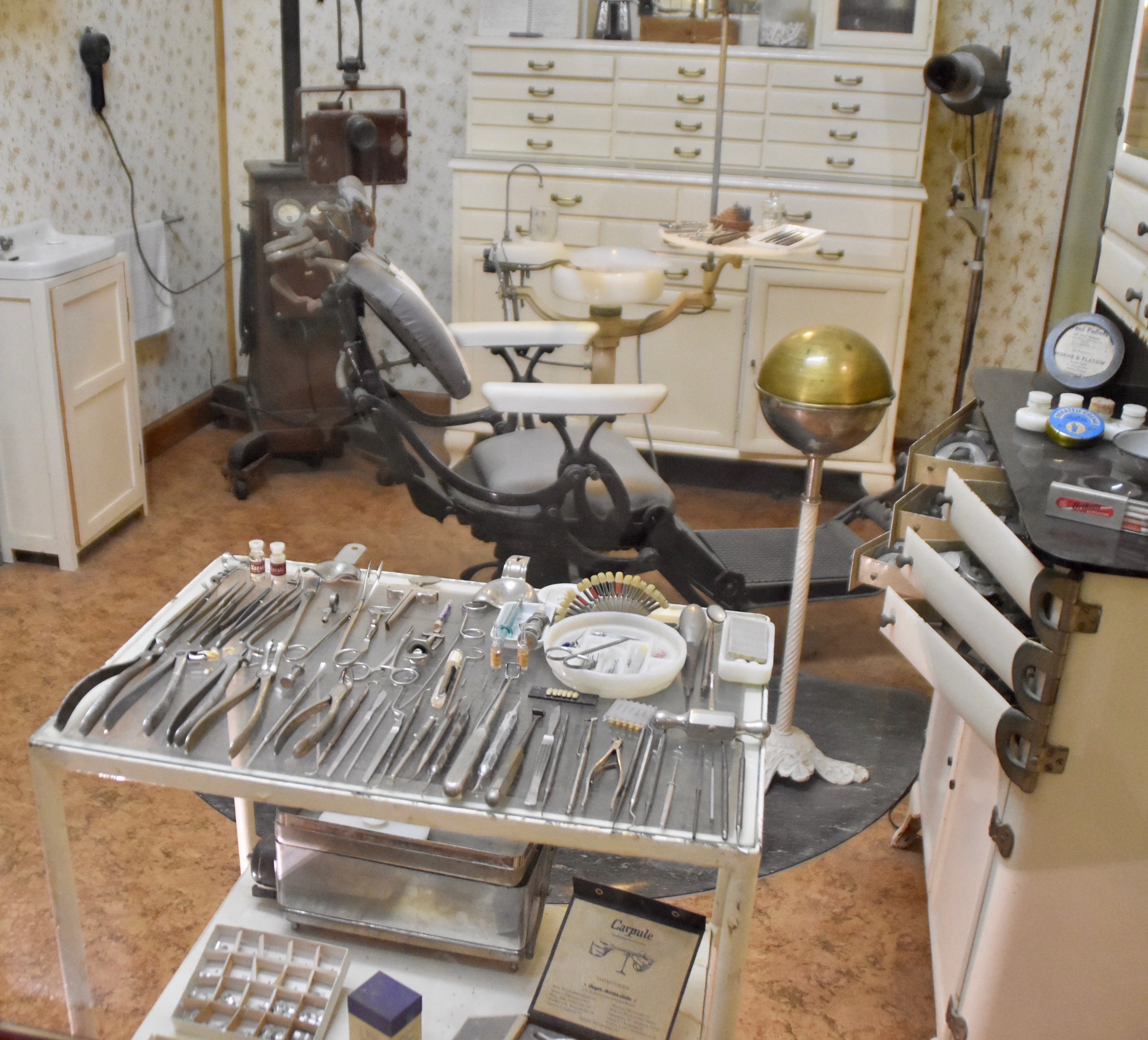
This is the Swakopmund jetty which, contrary to any jetty or pier I’ve ever visited, does not allow fishing. Still, I’ve never seen a pier that I didn’t want to walk to the end of and Swakopmund’s was no exception. Caught a fleeting glimpse of a porpoise at the end. What was really interesting was watching what I presume were Namibian tourists from maybe Windhoek who had obviously never seen the ocean before. They were taking selfies by the dozen and panning shots with their iPhones while giving an excited narrative to accompany the photos. For them this was something really special and Alison and I both caught their good vibrations.
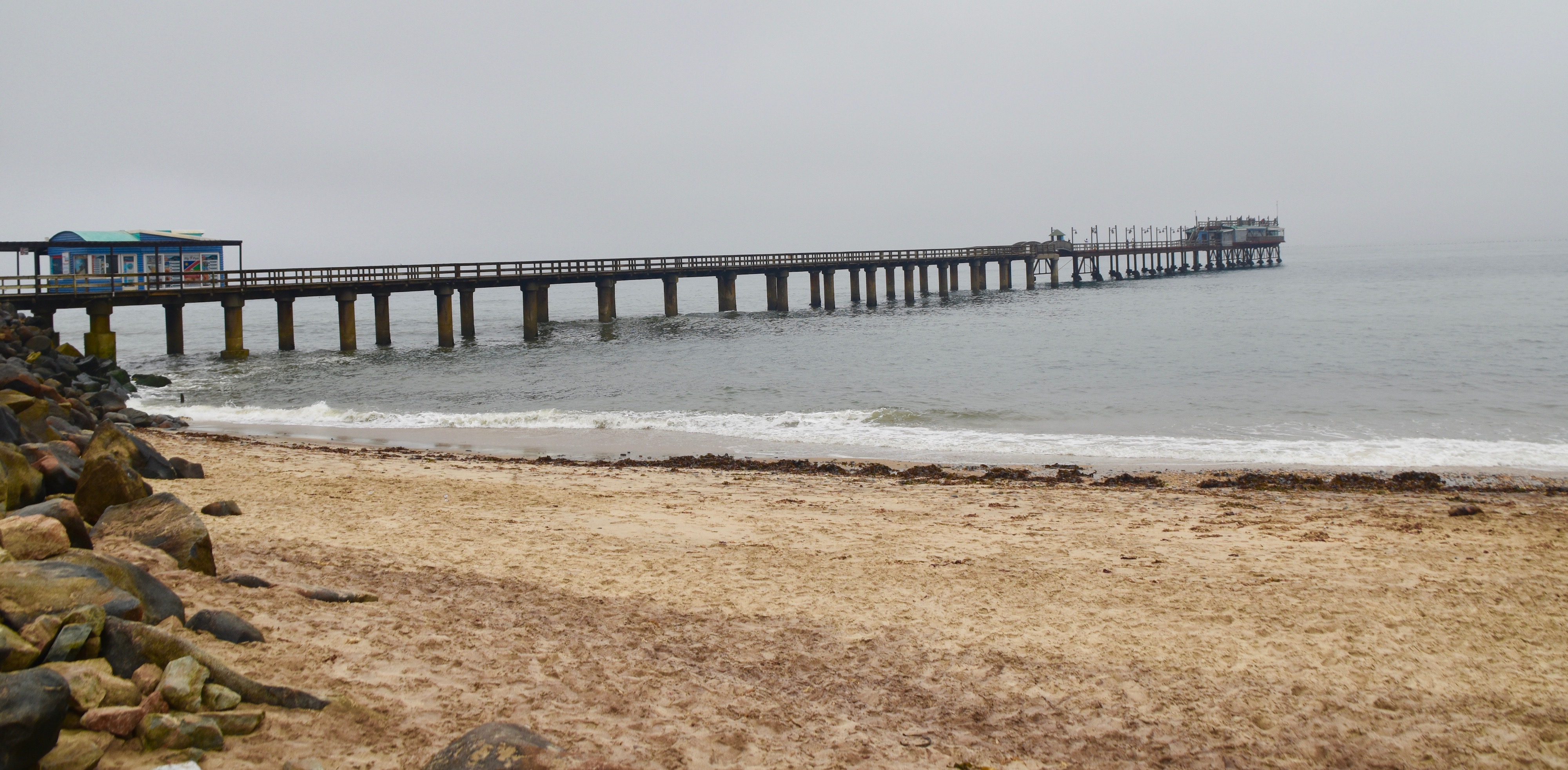
Close to the jetty is the National Marine Aquarium of which, frankly, I did not expect much. Once again, my innate prejudice against supposedly Third World institutions was shown to be exactly what it was – ignorant and facile. This was an excellent aquarium with a great three story tank containing dozens of native Namibian sea creatures. We easily passed over an hour just watching the sharks, rays, galjoen, steenbras and other species go round and round.
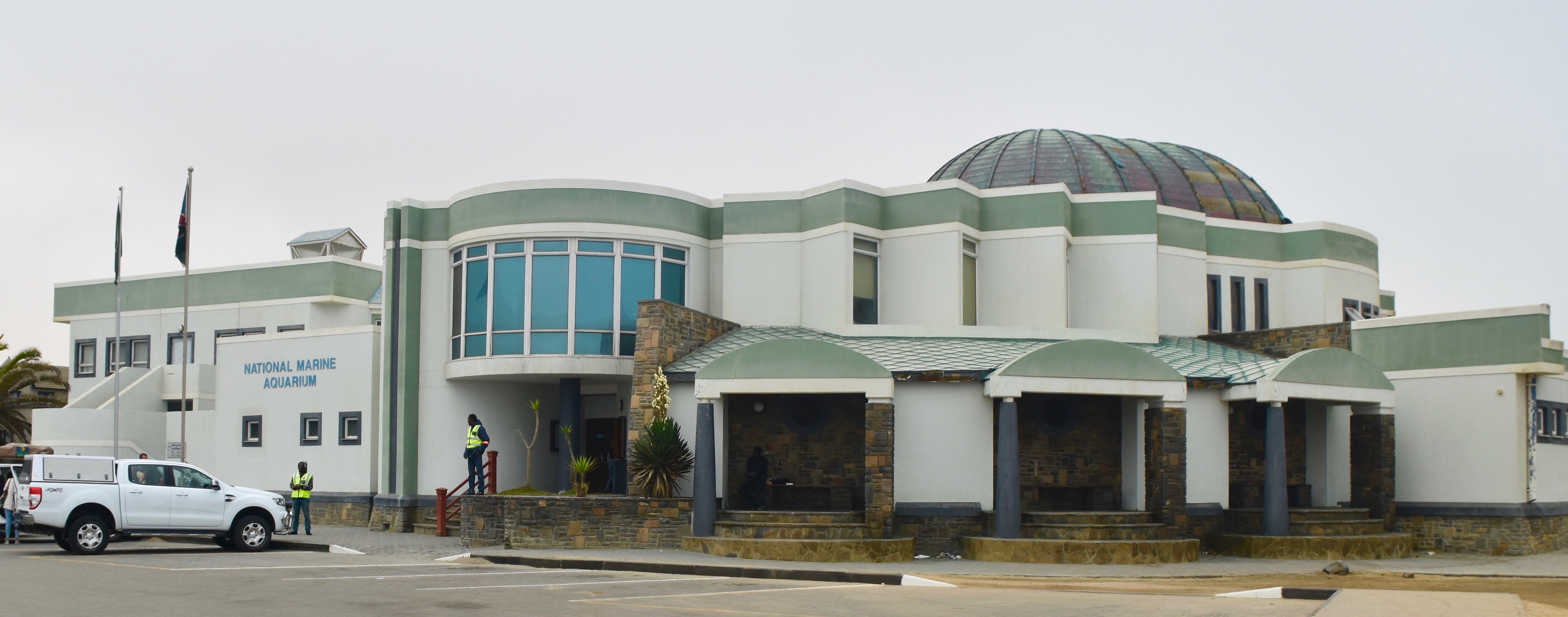
So, we had no problem whiling away the day in Swakopmund followed by a very nice dinner at the Hansa Hotel. For a place I’d never heard of, it was pretty impressive and a 180° degree change from the Namib Desert. Tomorrow we head to Gerhardus’ home territory of Damaraland where the temperature will soar once again. I hope you’ll join us.
Many thanks again to Dale for his keen eye and sharp attention to detail with his descriptions. Looking for more info on the tour he joined, search our Namibia tours.